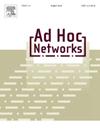AoI-Guaranteed UAV Crowdsensing: A UGV-assisted deep reinforcement learning approach
IF 4.4
3区 计算机科学
Q1 COMPUTER SCIENCE, INFORMATION SYSTEMS
引用次数: 0
Abstract
Unmanned Aerial Vehicles (UAVs), with their excellent environmental adaptability and flexible maneuverability, are increasingly being deployed in smart city applications for data collection. The Age of Information (AoI) is essential in these applications. Prior research on AoI has predominantly focused on static task scenarios, often overlooking the dynamics of task arrivals. For this reason, we propose an unmanned ground vehicle (UGV)-assisted deep reinforcement learning approach (U-DRL), which employs key factors affecting AoI to mitigate the AoI of data in dynamic task scenarios. We use EfficientNet, a state-of-the-art neural network architecture, to effectively extract features from dynamic task arrival scenarios. Based on these features, we utilize an intrinsic reward module (IRM) to swiftly process the input encapsulating global information, optimizing flight paths and enabling the exploration of expanded areas by UAVs. In addition, we leverage the active mobility of UGVs to recharge UAVs timely, thereby maximizing the flight time of UAVs. Through an extensive series of experiments, we validate the effectiveness of U-DRL. The experimental results demonstrate that U-DRL outperforms comparative algorithms in key performance metrics, significantly reducing the AoI of data, with breakthroughs of 54.14% and 67.90% in two real-world maps.
aoi保证无人机群体感知:一种ugv辅助的深度强化学习方法
无人机以其优异的环境适应性和灵活的机动性,越来越多地应用于智慧城市的数据采集。信息时代(AoI)在这些应用程序中是必不可少的。先前对AoI的研究主要集中在静态任务场景上,往往忽略了任务到达的动态。为此,我们提出了一种无人地面车辆(UGV)辅助深度强化学习方法(U-DRL),该方法利用影响AoI的关键因素来缓解动态任务场景下数据的AoI。我们使用最先进的神经网络架构effentnet来有效地从动态任务到达场景中提取特征。基于这些特征,我们利用内在奖励模块(IRM)快速处理封装全局信息的输入,优化飞行路径,使无人机能够探索更大的区域。此外,我们利用ugv的主动机动性及时为无人机充电,从而使无人机的飞行时间最大化。通过一系列广泛的实验,我们验证了U-DRL的有效性。实验结果表明,U-DRL在关键性能指标上优于比较算法,显著降低了数据的AoI,在两个真实地图中分别突破了54.14%和67.90%。
本文章由计算机程序翻译,如有差异,请以英文原文为准。
求助全文
约1分钟内获得全文
求助全文
来源期刊

Ad Hoc Networks
工程技术-电信学
CiteScore
10.20
自引率
4.20%
发文量
131
审稿时长
4.8 months
期刊介绍:
The Ad Hoc Networks is an international and archival journal providing a publication vehicle for complete coverage of all topics of interest to those involved in ad hoc and sensor networking areas. The Ad Hoc Networks considers original, high quality and unpublished contributions addressing all aspects of ad hoc and sensor networks. Specific areas of interest include, but are not limited to:
Mobile and Wireless Ad Hoc Networks
Sensor Networks
Wireless Local and Personal Area Networks
Home Networks
Ad Hoc Networks of Autonomous Intelligent Systems
Novel Architectures for Ad Hoc and Sensor Networks
Self-organizing Network Architectures and Protocols
Transport Layer Protocols
Routing protocols (unicast, multicast, geocast, etc.)
Media Access Control Techniques
Error Control Schemes
Power-Aware, Low-Power and Energy-Efficient Designs
Synchronization and Scheduling Issues
Mobility Management
Mobility-Tolerant Communication Protocols
Location Tracking and Location-based Services
Resource and Information Management
Security and Fault-Tolerance Issues
Hardware and Software Platforms, Systems, and Testbeds
Experimental and Prototype Results
Quality-of-Service Issues
Cross-Layer Interactions
Scalability Issues
Performance Analysis and Simulation of Protocols.
 求助内容:
求助内容: 应助结果提醒方式:
应助结果提醒方式:


